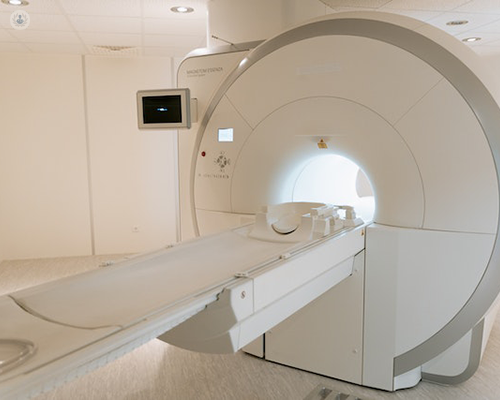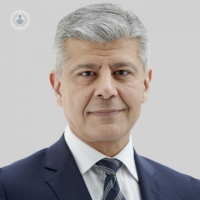Surgery for abdominal aortic aneurysm: Treatment options, complications and recovery
Written by:Although abdominal aortic aneurysms can be life-threatening if left untreated, surgical intervention also poses a risk of serious complications. As such, thorough evaluation and in-depth consultation from a specialist is required to determine the best course of action for each individual patient. To explain more on this complex topic, we invited revered consultant vascular surgeon Mr Maziar Mireskandari to share his expert insight on the different surgical approaches used to treat abdominal aortic aneurysm, the risk of complications and what the recovery period to follow entails.

What are the surgical treatments available for abdominal aortic aneurysms?
Once an abdominal aortic aneurysm (AAA) develops, there are no medications or other remedies that can reverse its progression. However, if the AAA is detected at an early stage, there are certain measures that can be implemented to prevent it from enlarging further. Typically, this involves strict management of blood pressure and addressing underlying factors such as elevated cholesterol levels or smoking cessation. In certain cases, these interventions can delay or even halt the advancement of the AAA. You can learn more about abdominal aortic aneurysms and how they develop by visiting my website.
In patients deemed physically capable of undergoing a procedure with AAAs measuring 5.5 cm or larger (or in specific cases as mentioned in my other article), the sole treatment option is surgery. Prior to surgery, a thorough discussion with a vascular surgeon who specialises in aortic aneurysm surgery is necessary to prevent further expansion or rupture.
In general terms, there are two types of surgical treatment: open surgery and endovascular aneurysm repair (EVAR).
Open surgery
Open surgery is performed with general anaesthesia. The surgeon enters the abdomen through an incision and the aorta is accessed in front of the spine. Clamps are then applied to the normal aorta both above and below the aneurysm. Next, the aneurysm sac is opened and a surgical graft made of Dacron fabric is sutured to the aorta above and below the diseased part. Once complete, the clamps are removed so that blood can flow through the graft and the aneurysm sac is oversewn.
Endovascular aneurysm repair (EVAR)
In endovascular aneurysm repair is performed through incisions made at the top of each leg which expose the arteries. A stent (made up of a tube of fabric supported by metal struts) is placed into the aorta using x-ray control. The stent is carefully positioned so that its top and bottom ends are found in healthy aorta above and below the aneurysm. Once in place, the sheath of the stent is withdrawn which allows the stent to spring into its open position. After the procedure, the blood flows through the stent graft rather than through the aneurysm sac.
What are the potential complications of surgery for AAA?
The most significant complication which must be discussed with the patient is mortality. Following open surgery, the risk of fatality is between one and three per cent and is less than one per cent after endovascular aneurysm repair (EVAR).
Despite the reduced risk associated with EVAR, subsequent complications are more likely to occur which will require additional corrective procedures. This risk has been reported to be as high as 20 per cent within a 5-year timeframe. As a result, patients who have undergone EVAR need to be closely monitored with CT or ultrasound. You can read more about CT scans and what they entail on my website.

Additional complications may include compromised blood flow to the lower limbs necessitating corrective surgical intervention, chest infection, kidney failure which requires temporary dialysis, and other issues that require individualised discussion.
Ultimately, the decision to proceed with surgery for AAA is only justified if the risk of rupture (if left untreated) outweighs all of the aforementioned complications. Additionally, carefully selecting which patients are suitable is essential. Therefore, establishing a comprehensive understanding between the patient and their vascular surgeons is crucial to achieve the best possible outcome.
What is the recovery period like following treatment?
After undergoing surgery, patients require close monitoring either in the High Dependency Unit (HDU) or the Intensive Care Unit (ICU), depending on the facilities available and the patient's needs. Typically, the initial 72 hours post-surgery are spent under close observation. Subsequently, patients are generally transferred to the surgical ward, where they will remain until they are discharged.
In the majority of cases, patients are discharged from hospital within five to fourteen days following surgery, depending on whether open surgery or endovascular aneurysm repair (EVAR) was performed.
Following discharge, it may take approximately 6 weeks for the tissues to fuse together and for all wounds to completely heal. Therefore, patients are advised to refrain from engaging in any physically demanding activities during this period. However, most of the pain and swelling should subside within 2 weeks of being released from the hospital.
The vascular surgeon will carefully monitor the patient and will usually conduct an outpatient consultation within seven to ten days.
What type of surgeon should perform surgery for AAA?
Only a vascular surgeon with specialist expertise in both open surgery and endovascular aneurysm repair can provide tailored guidance regarding the most suitable treatment for a specific case.
The facility providing the treatment should be an established centre for excellence in managing aortic conditions, with expertise in postoperative care within in high dependency and intensive care settings.
To learn more about abdominal aortic aneurysms, including the associated symptoms and diagnostic procedure, read Mr Mireskandari’s other article on the condition. You can also find extensive information on Mr Mireskandari’s website.
If you require treatment for abdominal aortic aneurysm and wish to schedule a consultation with Mr Mireskandari, visit his Top Doctors profile.



